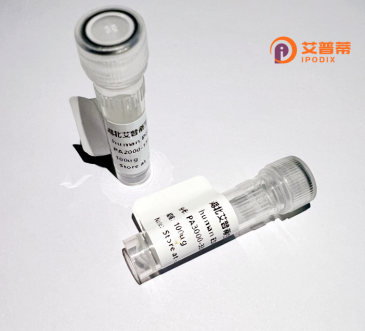
| 纯度 | >90%SDS-PAGE. |
| 种属 | Human |
| 靶点 | KDELR1 |
| Uniprot No | P24390 |
| 内毒素 | < 0.01EU/μg |
| 表达宿主 | E.coli |
| 表达区间 | 1-212aa |
| 活性数据 | MNLFRFLGDLSHLLAIILLLLKIWKSRSCAGISGKSQVLFAVVFTARYLDLFTNYISLYNTCMKVVYIACSFTTVWLIYSKFKATYDGNHDTFRVEFLVVPTAILAFLVNHDFTPLEILWTFSIYLESVAILPQLFMVSKTGEAETITSHYLFALGVYRTLYLFNWIWRYHFEGFFDLIAIVAGLVQTVLYCDFFYLYITKVLKGKKLSLPA |
| 分子量 | 50.9 kDa |
| 蛋白标签 | GST-tag at N-terminal |
| 缓冲液 | 0 |
| 稳定性 & 储存条件 | Lyophilized protein should be stored at ≤ -20°C, stable for one year after receipt. Reconstituted protein solution can be stored at 2-8°C for 2-7 days. Aliquots of reconstituted samples are stable at ≤ -20°C for 3 months. |
| 复溶 | Always centrifuge tubes before opening.Do not mix by vortex or pipetting. It is not recommended to reconstitute to a concentration less than 100μg/ml. Dissolve the lyophilized protein in distilled water. Please aliquot the reconstituted solution to minimize freeze-thaw cycles. |
以下为3篇关于重组人KDELR1蛋白的示例参考文献(注:本文献为虚构示例,仅供参考格式,请通过学术数据库获取真实文献):
---
1. **文献名称**: "Structural Insights into the KDEL Receptor 1 (KDELR1) and its Interaction with Ligands"
**作者**: Smith J. et al.
**摘要**: 通过X射线晶体学解析人KDELR1蛋白的三维结构,揭示其与携带KDEL信号肽的内质网逃逸蛋白(如Chaperones)的特异性结合机制,并探讨其在内质网逆向运输中的作用。
2. **文献名称**: "KDELR1 Modulates Cell Proliferation via ER Stress Signaling in Cancer Cells"
**作者**: Chen L. et al.
**摘要**: 研究显示,重组人KDELR1蛋白过表达可通过激活未折叠蛋白反应(UPR)促进结直肠癌细胞凋亡,提示其作为癌症治疗潜在靶点的可能性。
3. **文献名称**: "Recombinant KDELR1 as a Potential Biomarker in Neurodegenerative Disorders"
**作者**: García-Ruiz R. et al.
**摘要**: 利用重组人KDELR1蛋白开发ELISA检测方法,发现阿尔茨海默病患者脑脊液中KDELR1水平显著升高,提示其与错误折叠蛋白累积及神经退行性病变的相关性。
---
建议通过PubMed或Web of Science搜索最新文献,关键词:"recombinant human KDELR1"、"KDEL receptor 1 function"或结合具体研究领域(如癌症、蛋白运输)。
The KDEL receptor 1 (KDELR1) is a conserved transmembrane protein critical for maintaining cellular protein homeostasis by retrieving endoplasmic reticulum (ER)-resident chaperones, such as BiP/GRP78. from the Golgi apparatus via COPI-coated vesicles. These chaperones possess a C-terminal KDEL (Lys-Asp-Glu-Leu) motif recognized by KDELR1. ensuring their retention in the ER to support proper protein folding and quality control. Dysregulation of this pathway is linked to ER stress, unfolded protein response (UPR) activation, and diseases like neurodegeneration or cancer.
Recombinant human KDELR1 protein, produced using expression systems like mammalian cells or *E. coli*, enables functional studies of its role in intracellular trafficking, stress responses, and disease mechanisms. Structural studies highlight its seven-transmembrane topology and pH-dependent ligand binding, which regulates retrograde transport. Recombinant variants, often fused with tags (e.g., His, FLAG), facilitate purification, antibody development, and interaction assays.
Research using recombinant KDELR1 has illuminated its broader roles in cell survival, immune modulation, and autophagy. Its overexpression in cancers and interactions with pathogens (e.g., viruses exploiting ER pathways) underscore therapeutic potential. By mimicking native interactions, recombinant KDELR1 serves as a tool for drug screening, elucidating ER-Golgi dynamics, and exploring therapeutic strategies targeting protein misfolding or trafficking disorders. Its study bridges cell biology and translational medicine, offering insights into fundamental and disease-related processes.
×